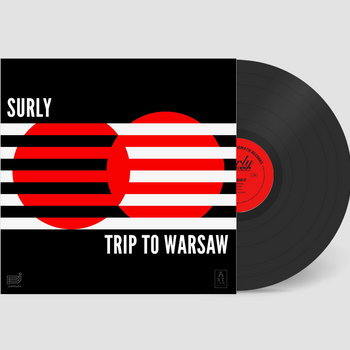
At first glance, Polish jazz and Chicago footwork aren’t two genres that go hand-in-hand. One is an improvised art form forbidden under Stalinist rule and recorded as part political protest, part experimental exploration; the other is the frenetic electronic patterning of rhythms and dubby bass produced to inspire dancers to move. Yet, for New Zealand-based producer Scott Ludvigson, aka Surly, the connections are apparent. His latest EP, Trip to Warsaw, is a collection of jazz-influenced footwork; its songs feature eerie horn samples, rattling basslines, and pensive melodies that inspire both movement and introspection.

Vinyl LP

“Chicago was a hotbed for jazz and blues in the early 20th century and that influence can be heard in the sampling used in Chicago house,” Ludvigson explains, citing dance music’s debt to jazz in iconic tracks like Mr. Fingers’s “What About This Love” or Kerri Chandler’s rework of Nina Simone’s “See Line Woman.” “A lot of footwork producers use harmonically complex chords and combine samples in ways that might seem to clash, but which create a tension and a sense of urgency that gives me the same feeling I get from jazz.”
The catalyst to Ludvigson realizing this association of genres and contexts was his father, Tom, a jazz musician who played with Krzysztof Ścierański from Polish fusion group Laboratorium. “Music was very important in my house growing up,” Ludvigson says. “It was never a question of if one does music; I thought everyone made music! At home we listened to a lot of jazz, but also electronic music from Kraftwerk to Dave Angel and Daft Punk. Dad was always into non-4/4 time signatures and that led me to embrace the polyrhythms of footwork.”

Vinyl LP

Tracks like “Thirteen” on Trip to Warsaw explore this blend of jazz-influenced polyrhythm and footwork electronics, employing sweeping drum brush strokes that are underpinned by a cavernous kick and softly tinkling piano melody. The acoustic and electronic are almost indistinguishable from one another, working together to create the tension and urgency that Ludvigson seeks.
“The sound of Polish jazz to me is this creepy, sinister one that makes you think of spy films,” Ludvigson explains. “It’s the mix of traditional scales and instruments with dark atmospheres, like the band is playing in the same room as you, but the lights are out and you can’t make out where they are or who is going to play what next. The fact that it was once forbidden leads to a music cloaked in mystery and darkness.” Filtering this subversive atmosphere through the mediating presence of footwork results in menacing numbers like the sparse hip-hop of “Scare Em To Death” and the DJ Rashad-style “Wait Til The Stick Comes,” placing both vocal samples over a teetering rhythm section.


Vinyl LP

Though jazz usually works best as a collaboration, Ludvigson’s wrote and recorded Trip to Warsaw alone. Any improvisation turned up in his sampling technique. “I would usually put on an album and do other things, like clean the house,” he explains, “then I’d hear something that grabbed me, and I’d get sucked into chopping the sample. Sixty to seventy percent of the time I’d throw away what I’d done if it didn’t work within the first 30 minutes.”
This process is not dissimilar to the process behind one of Ludvigson’s favorite Polish jazz records: Skalpel by Skalpel. Released in 2004, the album is constructed entirely of samples of Polish jazz, pieced together to approximate an acoustic recording. The end result is almost disorientingly cohesive, barely showing its seams or source material. Likewise, on Trip to Warsaw, the electronic footwork-influenced elements are used as another instrument within the sample, which is clearly evidenced in the closing number “Train to Lodz,” where a rumbling sub-bass approximates the bowing of a cello. “Sometimes I like digitally manipulated sounds and some of this can be heard on the sampled brass section on ‘4Q 510-511,’” Ludvigson says, “but for the most part, I wanted this project to sound clean and close to the source material: acoustic, dusty, spacious.”
It is this spaciousness that ties together the jazz and footwork elements. While the jazz samples include space as thinking and breathing time for instrumentalists before or after a solo, footwork uses space similarly for its dancers—keeping them on their toes by refusing to capitulate to a steady beat. “A few of these tracks like ‘Thirteen’ and ‘Scare Em to Death’ originally had more traditional footwork percussion, but I took it all away,” Ludvigson says. “I prefer the tension, that threatening void because when something is implied without being said, it doesn’t need to be said.”
Ludvigson’s work on Trip to Warsaw combines its sounds and samples in the service of a singular purpose: “Footwork is anything that makes the dancers push their dancing to new limits. The sounds you use don’t matter as long as they achieve the end result: making people want to footwork. This music is built to purpose and if you don’t like it, make something better or go listen to something else.”







